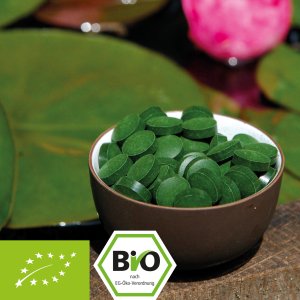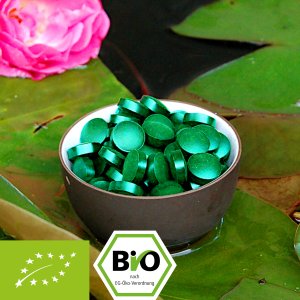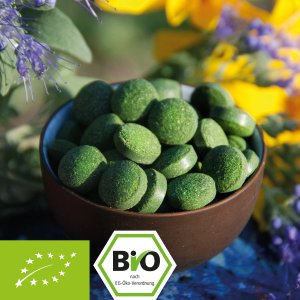A report on micro- and macroalgae in relation to world food, climate and environmental protection
Most people are probably already familiar with the microalgae Chlorella Algae (Bio) and Spirulina Algae (Bio) as healthy foods.
However, many people are probably unaware of the influence they had on the development of life on earth and the associated processes.
This is a pity, because algae in particular have already achieved great things in the past and can also contribute a great deal to the challenges of our time.
We therefore try to provide an insight into the origins, history and associated properties of microalgae and also to highlight the many possible uses and potentials.
Our focus will be on the connection between nutrition and climate change, which in turn leads us directly to the core competencies of chlorella, spirulina and co and their big siblings, the macroalgae, namely the production of extremely high-quality nutrients and the production of oxygen and the associated binding of carbon dioxide.
Algae to combat climate change and species extinction
Climate change and nutritional problems are two problems of our time that are unfortunately mutually dependent.
Due to the constant population growth, there is of course also a permanently increasing demand for consumer goods, which means that more and more raw materials, energy and also arable land are required.
Of course, this is not without consequences for the environment.
Around 30 million hectares of rainforest are cut down every year. This area is mainly used for the cultivation of soybeans, which in turn are needed as concentrated feed for cattle breeding, and the cultivation of palm oil.
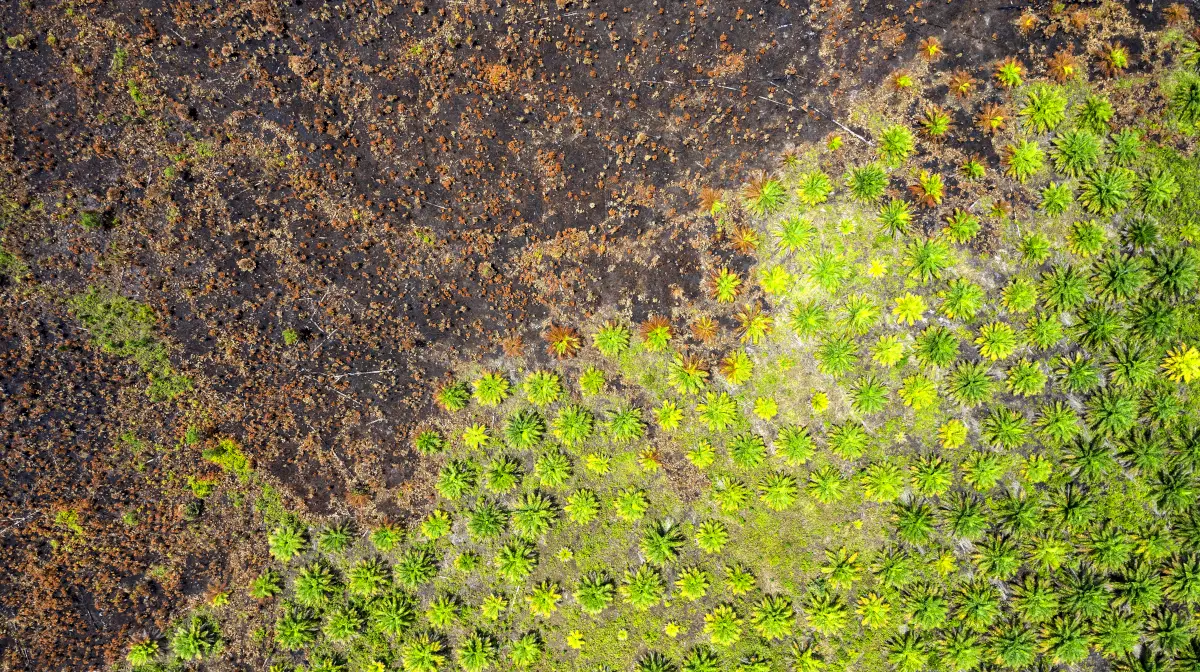
Rainforest clearing for palm oil plantations
On the one hand, this results in the destruction of the planet's "green lungs" and the disappearance of a large proportion of biological diversity, which in turn promotes desertification and encourages flooding, as the soil can no longer absorb heavy rainfall.
On the other hand, it ensures that even more CO2 is released into the Earth's atmosphere, as this is no longer stored in the form of biomass and therefore further increases the greenhouse effect.
This can currently be observed particularly clearly in Brazil and in recent years in Indonesia and Malaysia.
This is supported by excessive cattle farming and the associated methane emissions, which, like CO2, has a greenhouse effect.
Of course, this poses additional challenges, especially for countries that are already struggling with crop failures due to drought, as they are among the hardest hit by the effects of climate change.
So how can algae contribute to solving these dilemmas?
No oxygen without cyanobacteria and microalgae
To answer this question, we need to jump back 2.7 billion years in time to the Tertiary period and look at the emergence of cyanobacteria and microalgae.
At that time, the Earth was an inhospitable place, largely devoid of oxygen with a thin atmosphere consisting mainly of water vapor, carbon dioxide, methane, hydrogen sulfide and nitrogen. These elements were also found in the primordial oceans, the so-called primordial soup, which covered the earth with a mixture of water, sulphur compounds and ammonia.
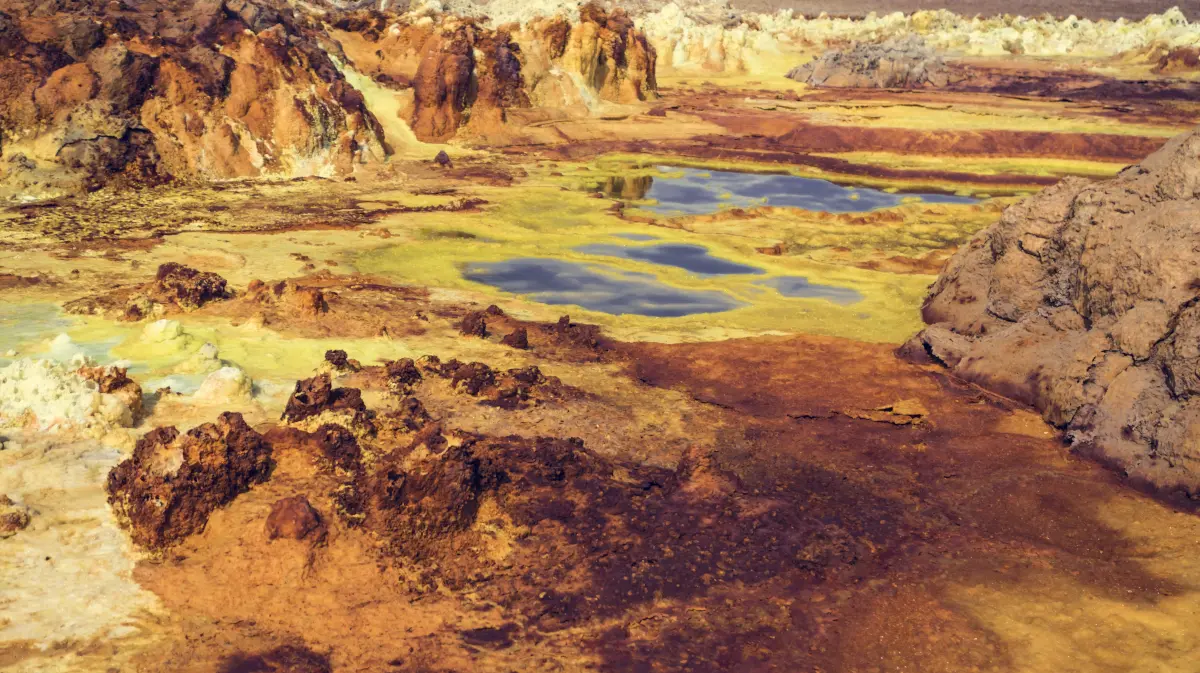
Primordial soup 3.5 billion years ago
It is hard to imagine that cyanobacteria, also known as blue-green algae, such as spirulina, could form under these hostile conditions.
Nevertheless, these organisms, which belong to the prokaryotes, i.e. bacteria without a cell nucleus, were the prerequisite for the formation of further life on Earth.
However, we are still several hundred million years away from the emergence of so-called eukaryotes, i.e. the first single-celled organisms such as Chlorella, as they require oxygen to live.
However, this first had to be produced.
This is where cyanobacteria came into play, as they are viable in the absence of oxygen and at the same time able to produce energy through photosynthesis. This is why they are also known today as blue-green algae, as they also have the characteristics of algae.
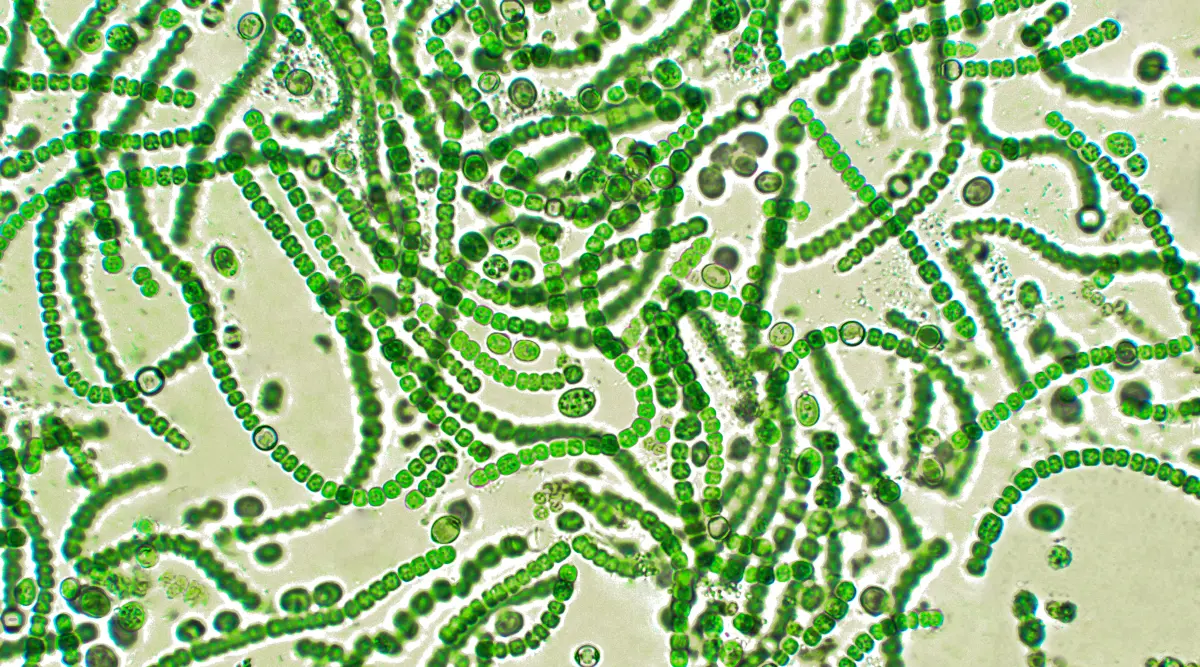
Cyanobacteria - blue-green algae - spirulina under the microscope
Spirulina's first relatives began to produce oxygen, which was actually only a by-product of photosynthesis, under the most adverse conditions, simultaneously binding carbon dioxide and thus initiating one of the greatest transformation processes that has ever taken place on this planet. The earth began to "rust", so to speak. They thus created the foundation for all further life on earth and first and foremost paved the way for the first microalgae with cell nuclei such as Chlorella.
These first unicellular algae then formed around 1.9 billion years ago and took over the planet in great diversity over the following 1 billion years.
It can be assumed that these microalgae and blue-green algae are essentially unchanged even after several billion years of development and still eke out an existence today in sometimes inhospitable regions. Both species are still extremely tolerant of dehydration, salt water but also cold and heat and therefore grow, for example, in glaciers and hot springs up to 70 degrees Celsius.
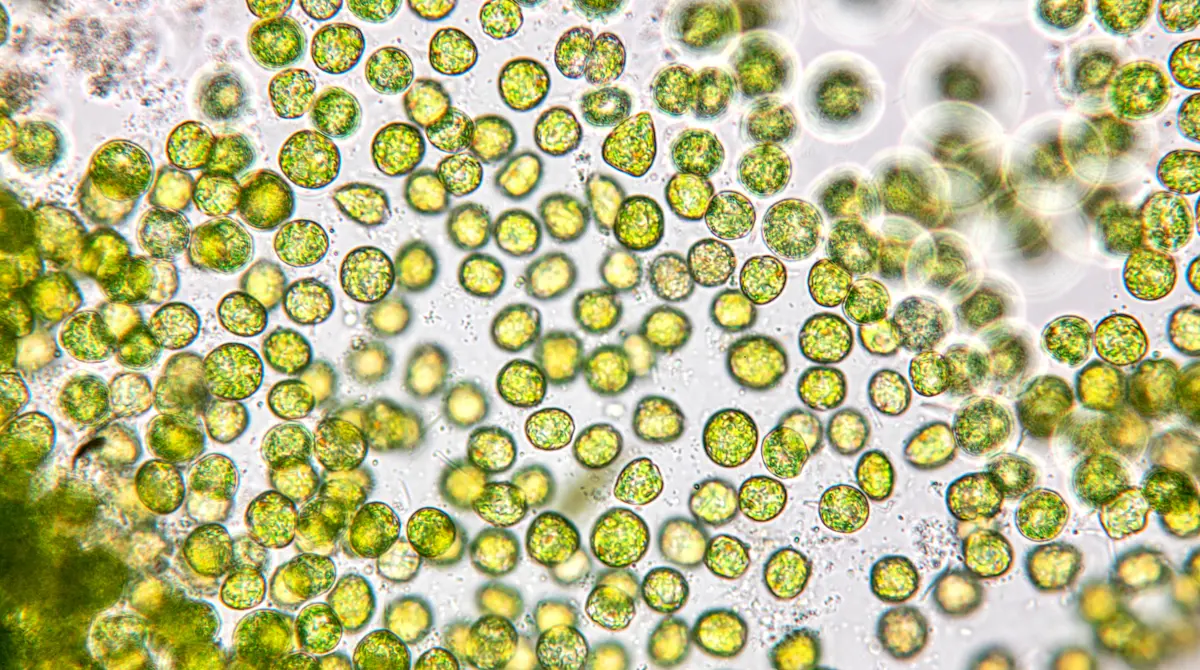
Chlorella microalgae under the microscope
So these were the first tiny creatures on earth that were able to initiate the greatest transformation process on the planet under the most extreme conditions and are therefore jointly responsible for the formation of our earth's atmosphere and ultimately form the foundation for the emergence of all life on our planet.
So what could be more obvious than to rely on their expertise again for our nutritional, climate and environmental problems?
Chlorella and spiruina - climate protection and nutrition optimally combined
But what can microalgae do to combat climate change and nutritional problems? The answer is very simple.
Cultivating algae such as spirulina and chlorella is very efficient because, as we already know, algae are able to grow well and produce high levels of nutrients even under poor conditions.
Chlorella and spirulina can produce 10-15 times the amount of protein than is possible when growing soybeans.
So while new areas of rainforest are constantly being cleared for soybean cultivation, which is mainly used to produce animal feed, microalgae cultivation can be carried out in coastal desert regions and combined with reforestation projects at the same time.
This sounds like a contradiction at first, but on closer inspection it turns out to be an ingenious way of "killing two birds with one stone", namely reforestation and nutrition in regions that are actually rather hostile to life.
The solution here is so-called seawater greenhouses.
Greenhouses for green growth in the desert
The basic idea is simple: convert salt water into drinking water. Because there is actually enough water in the world, most of it is just too salty.
There are now several variants of this.
The oldest solution probably dates back to the 1970s and was developed by the Hamburg engineer Dr. Rolf Bettaque and tested in the Israeli Negev Desert back then.
In this approach, which is basically very simple, a greenhouse is equipped with 2 roofs, one above the other. The lower roof is constantly flooded with salt water, which evaporates due to the heat and condenses on the upper roof, from where it runs off and is used for irrigation. However, the project never made it to series production.
Other projects are more promising and are already in use in some countries.
Charly Paton's "Seawater Greenhouse" project has been in use in various countries for around 20 years and follows a similar approach to that of Bettaque.

Principle of a seawater greenhouse
Here, too, the basic principle is the extraction of fresh water from salt water and this approach also works very simply.
With the help of solar-powered pumps, the cool seawater is pumped to the greenhouses, where it is fed through air-permeable sponge-like walls at the front.
At the back of the greenhouse, large fans draw hot desert air through the sponge structure into the interior of the greenhouse.
When it hits the sponge structures, the hot desert air is saturated with water and cools down as a result. On the one hand, this causes the temperature inside the greenhouse to drop, creating a temperature level that is suitable for growing plants, and on the other, it transports fresh water inside the greenhouse. But the process does not end there, as the air also leaves the greenhouse again at the back.
There, the air is once again passed through the sponge-like wall structures. On this side, however, they are soaked with hot salt water, which is fed through pipes on the roof of the greenhouse and heated by the sun.
The air is therefore saturated with fresh water again here and then fed through a system of vertical pipes containing cool seawater. This causes the water contained in the air to condense and run off into a water reservoir. The water obtained in this way can be used for additional irrigation. Surplus water can be used for reforestation or as drinking water.
The advantage is that no pesticides are needed because the salt water kills pests. Minerals extracted from the brine can be used as fertilizer.
The seawater greenhouse would therefore provide optimum conditions for cultivating organic chlorella or organic spirulina. On the one hand, it provides clean drinking water and nutrients and, on the other, it does not require the use of pesticides. In this way, high-quality algae can be cultivated without wasting drinking water and saving resources for fertilization.
Since, unlike chlorella, spirulina cultivation does not necessarily require fresh water, spirulina could also be cultivated directly in salt water.
But Paton's solution could also be improved and so Charlie Paton has been cooperating with other partners for several years under the name "Sahara Forest Project".
The Sahara Forest Project was developed by architect Michael Biomimetik Pawlyn, seawater greenhouse designer Charlie Paton and structural engineer Bill Watts. In 2009, the trio joined forces with Bellona, an international environmental protection organization based in Norway, and presented their proposals at COP15 of the 15th UN Climate Change Conference in Copenhagen.
This variant already uses saltwater macroalgae production. However, spirulina is also ideal for this, as it grows in both salt and fresh water, so the fresh water obtained could be used for other purposes. Another possibility would be the use of photobioreactors, i.e. closed tube systems in which microalgae grow under controlled conditions.
But why microalgae such as chlorella and spirulina? Well, as already described, these algae are extremely resilient and grow under the most adverse conditions, such as extreme heat and cold, but can also survive several decades of drought. They are therefore suitable from the outset for cultivation in areas that are unsuitable for regular agriculture.
Both algae are extremely productive, meaning that they can both be used to produce high-quality food.
But the possibilities of spirulina and chlorella are far from exhausted.
Combined water purification and energy production with algae
Both microalgae and macroalgae are ideal for the production of CO2-neutral biofuels such as biodiesel or bioethanol. This is because they are very oily.
Chlorella algae in particular stands out here, as it has other positive properties that can be used in fuel production.
Chlorella has the ability to bind pollutants such as nitrate and phosphate. Both substances are used as fertilizers in agriculture and as a result are often found in groundwater, but also in lakes and rivers near the surface, where they damage the environment in excess. Chlorella algae can now be used specifically to combat pollutants.
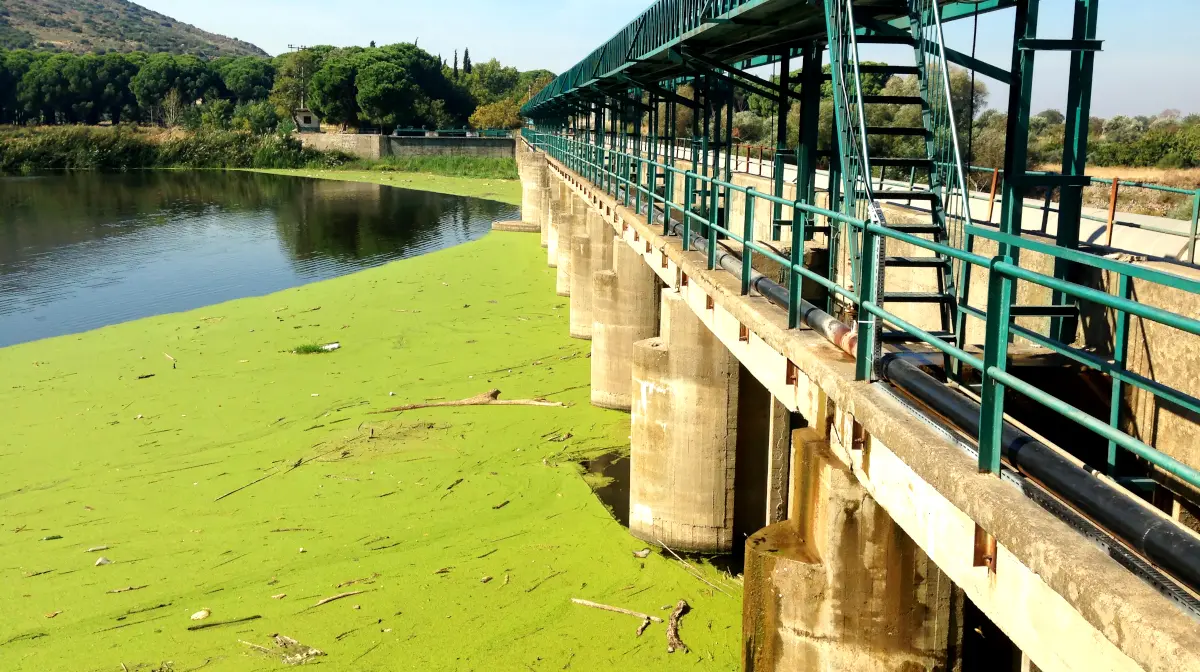
Algae for water purification
The algae also uses nitrate and phosphate to form proteins and thus to grow. In this process, it removes the pollutants from the water and thus contributes to purification. The advantage here is that chlorella only needs one of the two substances to grow. This means that even if one of the two substances disappears from the water during purification, algae growth does not stagnate.
However, it is not only nitrate and phosphorus that are bound by the algae, but also heavy metals such as lead, cadmium and chromium. Studies have shown that a combination of microalgae with certain bacterial strains accelerates algae growth even further and ensures that up to 93% of the heavy metals in the water are bound by the algae.
During the growth process, however, the algae bind not only nitrogen and phosphorus, but also carbon dioxide. For 2 kg of algae mass, 2 kg of CO2 are required. In return, of course, oxygen is released.
At the end of this growth process, a very oily and therefore energy-rich algae is produced, which can be used in different ways. On the one hand, it can be fed into biogas plants and used to generate energy. The remaining so-called fermentation residue can then be spread on the fields as fertilizer. This creates a cycle.
Accelerating the energy transition - algae as a sustainable fuel supplier
However, as mentioned above, the algae mass can also be used as a CO2-neutral fuel supplier.
The so-called triacylglycerides, in simple terms natural fats contained in the algae, can be extracted and then refined into fuel, e.g. biodiesel. They thus serve as an alternative to crude oil.
Unfortunately, it must be realized that the quantities that can be produced in this way would never be sufficient to replace the need for fossil fuels. However, as valuable arable land is currently being lost to biofuels, this may provide an alternative to the current production process.
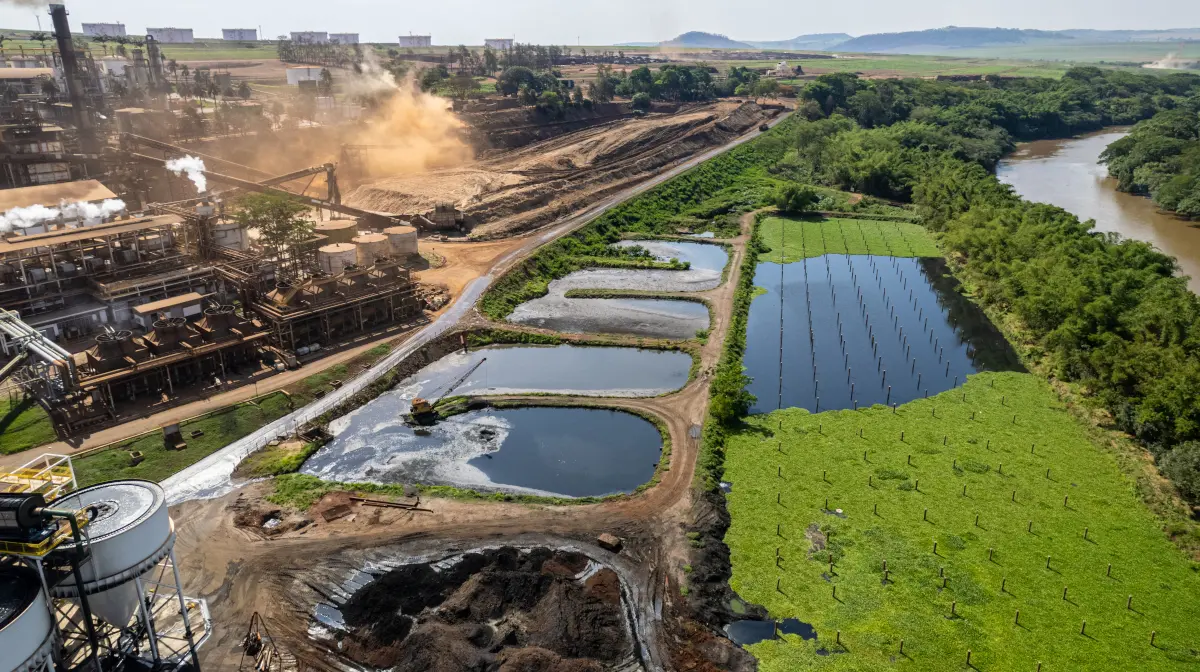
Biomass refinery in Brazil
As described at the beginning of the text, the same applies to the production of palm oil and the cultivation of soy products for animal feed.
Large areas of rainforest are being cleared for both palm and soy cultivation. Microalgae could counteract this development.
As microalgae are very oily and mainly contain unsaturated fatty acids, they could at least partially replace palm oil. The same applies to feed soy. Dried algae contain up to 50% more protein than soybeans and would therefore be an ideal concentrated feed substitute for livestock farming. Due to their rapid growth, more biomass can be produced in a shorter time. The relatively difficult digestibility of chlorella, for example, also plays no role in cattle breeding and the high oil content of the algae even results in a higher omega-3 fat content in the milk.
This process could therefore at least partially contribute to curbing rainforest deforestation.
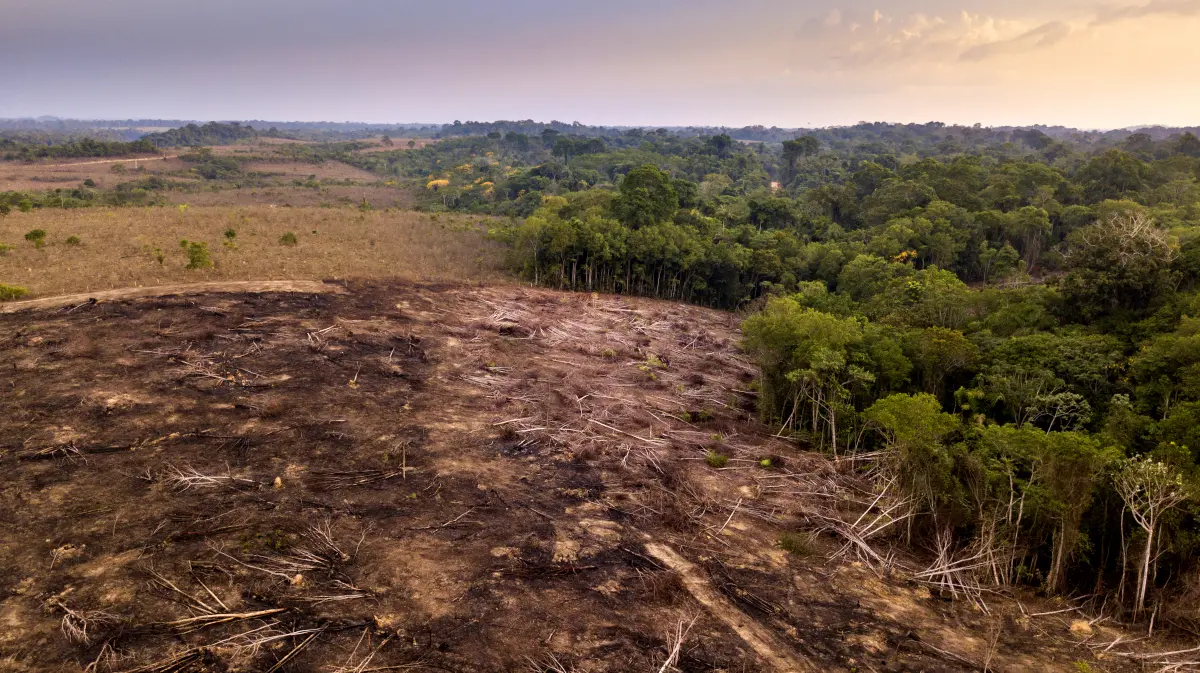
Rainforest deforestation
This could play a special role in Brazil. Here, rainforest deforestation unfortunately reached a sad record in 2022.
In just one month, 904 square kilometers of rainforest were cut down in October 2022.
This is not only an absolute disaster for climate change, but also for biodiversity. Flora and fauna will find it very difficult to ever recover from such cuts. The ecosystem as we know it now will simply cease to exist if the abuse continues.
This makes it all the more important to take action at all levels to counteract climate change, species extinction and environmental pollution.
Brazil has actually been using a fuel production system that is actually CO2 neutral for several decades.
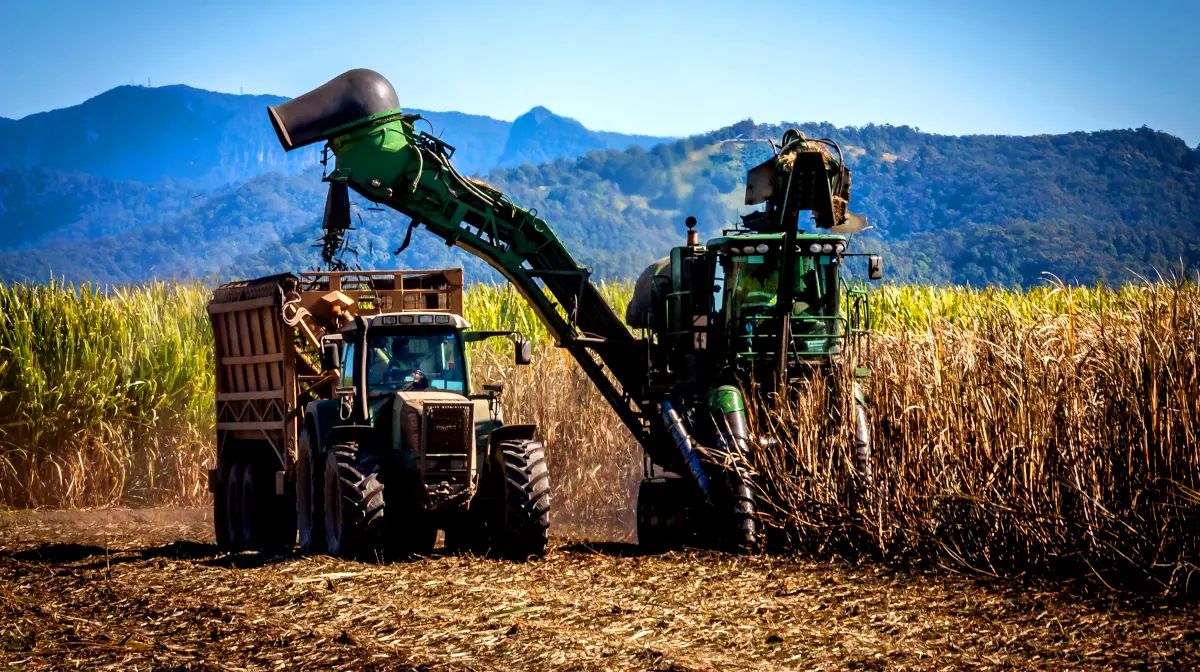
Sugar cane harvest in Brazil
Almost every car in Brazil runs on both regular gasoline and ethanol.
Brazil is one of the largest producers of bioethanol in the world. Sugar cane grows particularly well and quickly in the tropical climate, and its high sugar content makes it ideal for the production of ethanol.
So far so good. The problem, however, is that growing sugar cane requires land that is increasingly being cleared from the rainforest. This is of course nonsense and does more harm than good.
Microalgae can also be a sensible alternative here. Fast-growing, they produce energy-rich biomass on a much smaller area.
Spirulina platensis in particular has shown promising results in the production of bioethanol and could therefore help to at least curb rainforest deforestation in the future.
In the future, however, not only microalgae but also macroalgae could be considered in this area.
The big brothers and sisters of microalgae - macroalgae
Macroalgae have different potential than microalgae. Most people are probably familiar with them as seaweed from vacations by the sea, where they are usually found in abundance on the beach.
Macroalgae are already being used in a variety of ways.
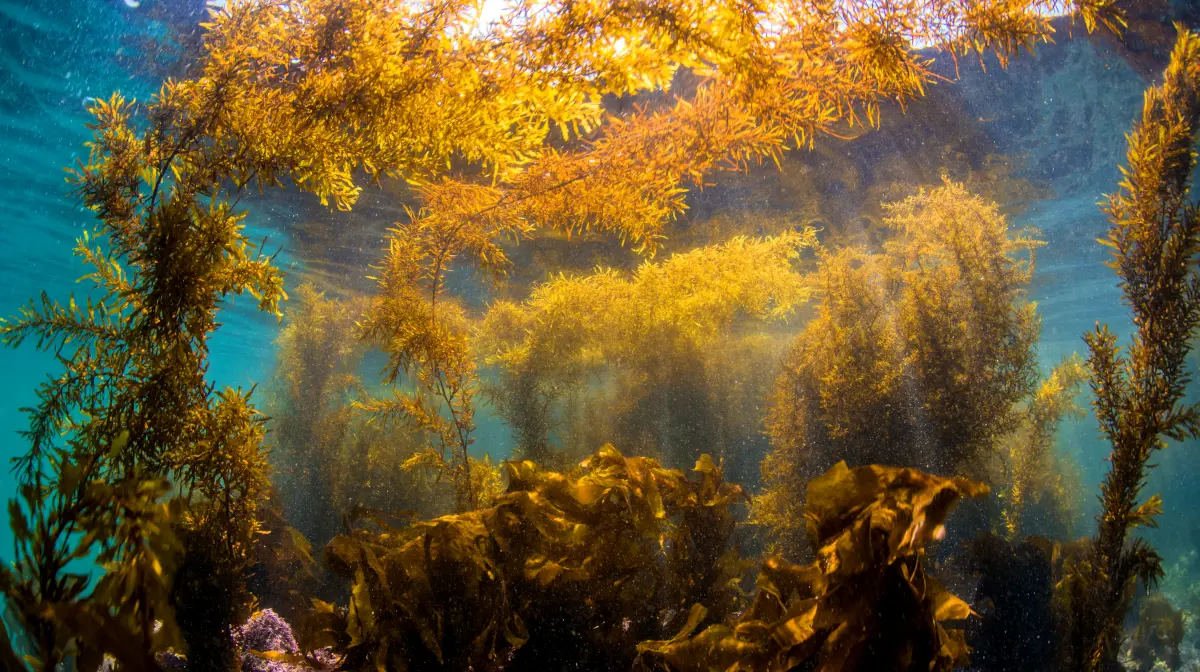
Underwater image of macroalgae/seaweed
They are particularly popular in Asian countries. In this country, we are probably most familiar with nori seaweed as a coating for sushi rolls or the bright green wakame seaweed salad. Both are very rich in iodine and are therefore valued as a valuable source of iodine in vegan diets. But caution is advised here. The iodine content of these algae can fluctuate greatly and in some cases have significantly excessive iodine levels. In some cases, the levels are so high that damage to the thyroid gland cannot be ruled out. This was discovered by Stiftung Warentest in one of its studies.
The occasional sushi is certainly not harmful, but anyone who regularly eats seaweed should make sure that the manufacturer checks the iodine content.
Seaweed is also used in medicine, e.g. for making compresses, as a wound filler or stomach acid blocker.
But now algae are supposed to help us with another problem. They are supposed to help us get to grips with the flood of plastic and at the same time reduce the amount of CO2 in the atmosphere.
Algae as a sustainable plastic substitute
Macroalgae offer a major advantage. They consist of an extremely tough and resistant material, known as polymers, which are also very flexible. These are properties that they share with plastic. This is not surprising, as plastic is made from crude oil, which in turn is the result of the transformation of organic, mainly plant material over millions of years.
The material that makes up the polymer in algae are hydrocolloidal structural polysaccharides, such as agar, alginate and carrageenan.
The term "hydrocolloid" is derived from the Greek word "hydro" meaning water and "kolla" meaning glue. This means that they bind water on the one hand and form a certain stability on the other.
This can be utilized in the production of a plastic substitute. There are already various companies that use algae to produce plastic substitutes.
The following video provides an insight into the advantages that macroalgae offer and introduces a company that is working successfully with the new "algae plastic".
However, the plastic substitute offers even more possibilities compared to conventional plastic. Regular plastic is made from petroleum, which causes several problems. Products made from this material decompose poorly or not at all. As a rule, they only continue to break down into smaller components until they are present in the form of microplastics, which are now found in the environment, soil, water, many foods and drinking water and therefore naturally also end up in the human body. According to the current state of research, it is not yet known whether this harms the human body.
On the other hand, CO2 is released when the plastic does not simply decompose, but is incinerated, for example, because it is no longer suitable for recycling.
This CO2, which was previously bound in the earth's crust in the form of oil, naturally enters the earth's atmosphere and thus further drives climate change.
By replacing some of the plastic with algae, at least some of the CO2 emissions are recycled.
As the algae bind carbon dioxide during their growth, only this amount is released again when the product is broken down.
An additional positive effect is the water purification during algae growth. During the growth process, the algae bind pollutants such as nitrate and phosphate, as described earlier in the text, and convert them into growth energy.
But that's not all. Algae have further potential to counteract climate change.
Rethinking agriculture with algae
In addition to carbon dioxide, there is another greenhouse gas that occurs in smaller quantities in the atmosphere but has a significantly higher greenhouse gas potential: methane.
The global warming potential of a gas describes the climate impact of a gas over a certain period of time, for example 100 years, in relation to carbon dioxide.
This is then expressed in so-called carbon dioxide equivalents.
In this calculation, one tonne of methane is just as harmful as 25 tonnes of CO2 over a period of 100 years.
Overall, methane emissions have been falling steadily for years. However, one sector that emits methane at a consistently high level is agriculture, especially livestock farming.
However, this can be counteracted by using certain types of algae. In this case, it would not be microalgae that would be used, as described above, but certain types of macroalgae. When added to cattle feed, for example, various types of macroalgae have the property of significantly reducing methane emissions, in some cases by over 90 percent.
One algae in particular, Asparagopsis, which is native to Australian waters, stands out in this respect.
Another positive effect is that the amount of feed can be reduced, which does not make the addition of algae to feed more expensive. At the same time, farmers who additionally feed their animals with algae could be offered compensation payments for the emissions saved.
However, in order to use algae on a large scale in all these areas, the current stocks are certainly not sufficient and we would have to start cultivating them on a large scale on algae farms.
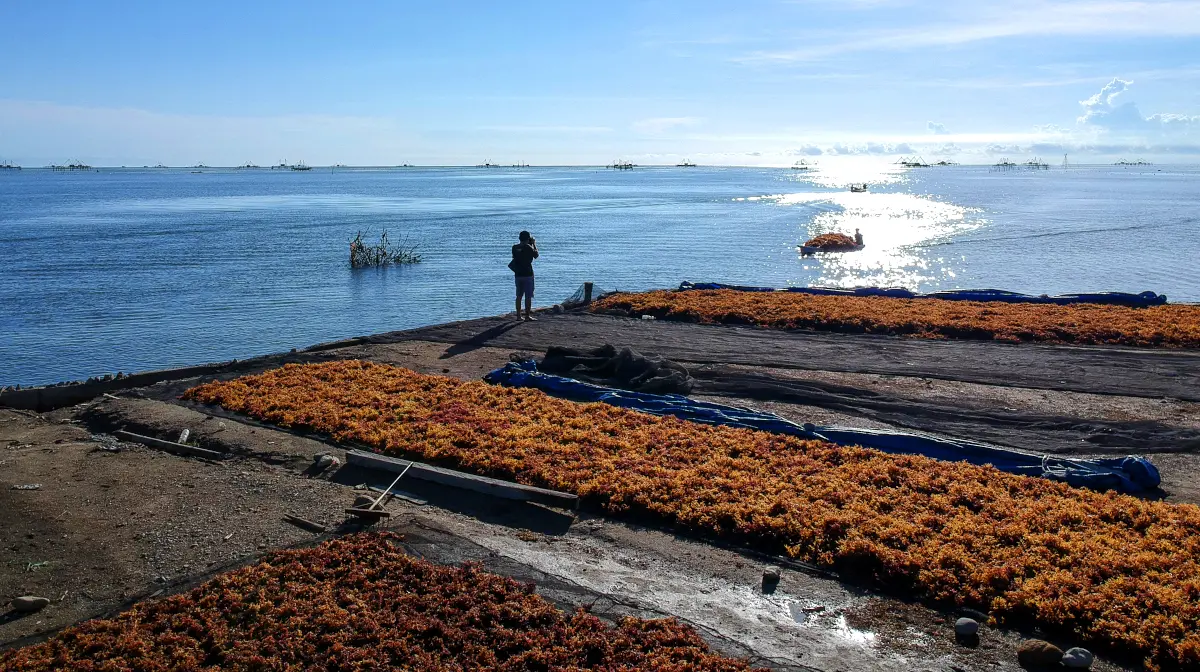
Algae drying on algae farms
Macroalgae - the CO2 reservoir of the future?
Algae farms already exist today. In most coastal regions of the world, seaweed is cultivated to a greater or lesser extent for human use.
However, in order to capture CO2 to the extent required globally, much larger farms would be needed and the algae would have to be harvested continuously and not only transferred to a circular economy, as this would limit CO2 storage, but the algae mass would have to be stored permanently and protected from decay.
To this end, some scientists propose lowering the algae to the bottom of the deep sea.
There they would be covered with sediment and thus stored in the absence of oxygen. This would be the same system that made oil formation possible millions of years ago.
You can find an exciting report on this in the following Arte video.
A different kind of CO2 storage facility is already in the test phase. To get to know it, let's come back to the microalgae. These are being used in Belgrade and Paris in so-called photo-bio-reactors. This is a large glass container, similar to an aquarium, which is filled with water and a microalgae culture. The CO2-containing city air is then passed through this water, which stimulates the algae to grow and produce oxygen, thereby purifying the air in city centres.
In winter, this system requires some additional heat, which can be obtained from photovoltaics.
The photo-bio reactor is much more efficient than trees would be. On average, it removes as much CO2 in one year as a tree does in 10 years. The resulting biomass could be reused to generate energy or as fertilizer. There is also an explanatory video on this. :)
In conclusion, it remains to be said that algae will certainly not be the solution to all our problems, but they can certainly make a significant contribution in the areas of climate change, world nutrition, waste avoidance and energy production.
The UN has also recognized this and in its "Seaweed Manifesto" once again outlines the benefits, but also the challenges and risks that a new algae industry will bring. Let's hope that it doesn't just remain an outline, but that it is also implemented. With this in mind: Eat more Algae & Extracts! :)
